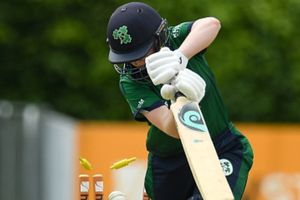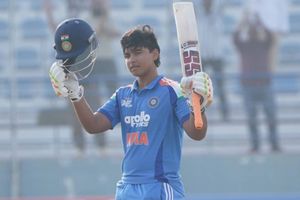The thrilling Royal Challengers Bengaluru (RCB) between Punjab Kings (PBKS) was marred by a contentious moment in the latter stages when Digvesh Rathi attempted a run-out at the non-striker's end, involving Jitesh Sharma.
Digvesh Rathi's controversial Mankad attempt causes controversy
It all happened on the final ball of the 17th over. Rathi, the LSG spinner, dislodged the bails after finding RCB's stand-in skipper, Jitesh Sharma, outside his crease. Replays confirmed that Jitesh was indeed out of his popping crease, which would typically result in a dismissal. However, ground visuals also showed a seemingly heartwarming moment where Rishabh Pant withdrew the appeal and shared a hug with Jitesh. Despite this gesture, the reality of the situation was that even if Pant had not withdrawn the appeal, Jitesh would not have been out due to the specific rules surrounding the Mankad dismissal.
Jitesh Sharma was deemed not out in Digvesh Rathi's Mankad appeal because the bowler had already completed his action before dislodging the bails. According to changes made by the MCC (Marylebone Cricket Club), a bowler is no longer permitted to execute a non-striker's run-out after completing their bowling action.
During the review of the incident, the third umpire was heard stating, "The bowler has passed his delivery stride in his popping crease," before ruling Jitesh Sharma not out. However, it's important to note that neither the IPL Playing Conditions nor the MCC Laws mention the bowler's delivery stride or popping crease as factors in determining the legality of such a run-out attempt.
In fact, the sole condition for a legal run-out attempt at the non-striker's end is that the bowler must attempt it before their arm "reaches the highest point of his/her normal bowling action in the delivery swing." Digvesh Rathi clearly had not reached this highest point in his delivery swing, which would technically make his run-out attempt legal. Nevertheless, in this particular case, even if the third umpire had given Jitesh out, the decision would have been immaterial due to Rishabh Pant's withdrawal of the appeal, a move he is entitled to make.
Here's what the rules say:
The MCC (Marylebone Cricket Club), the governing body responsible for setting cricket's rules, updated the non-striker run-out law in 2022 to enhance fairness and clarity.
In simple terms, the rule states that a bowler can only run out a non-striker who has left their crease early if the bowler acts before completing their bowling action. Once the bowler's arm has reached the highest point of their normal bowling action (the point where they would typically release the ball), it is no longer permissible for them to run out the non-striker under this law, even if the batter is out of their crease
MCC Law 38.3.1: A non-striker can be run out - from when the ball is in play until the moment the bowler’s arm reaches the highest point in their normal bowling action (when they would usually release the ball).
MCC Law 38.3.1.1: The bowler can break the stumps with the ball (by throwing or holding it) to run out the non-striker if they are out of their ground before this point.
MCC Law 38.3.1.2: Once the bowler’s arm passes the highest point of their bowling action, they can’t run out the non-striker, even if the batter is out of their crease.
ADVERTISEMENT










